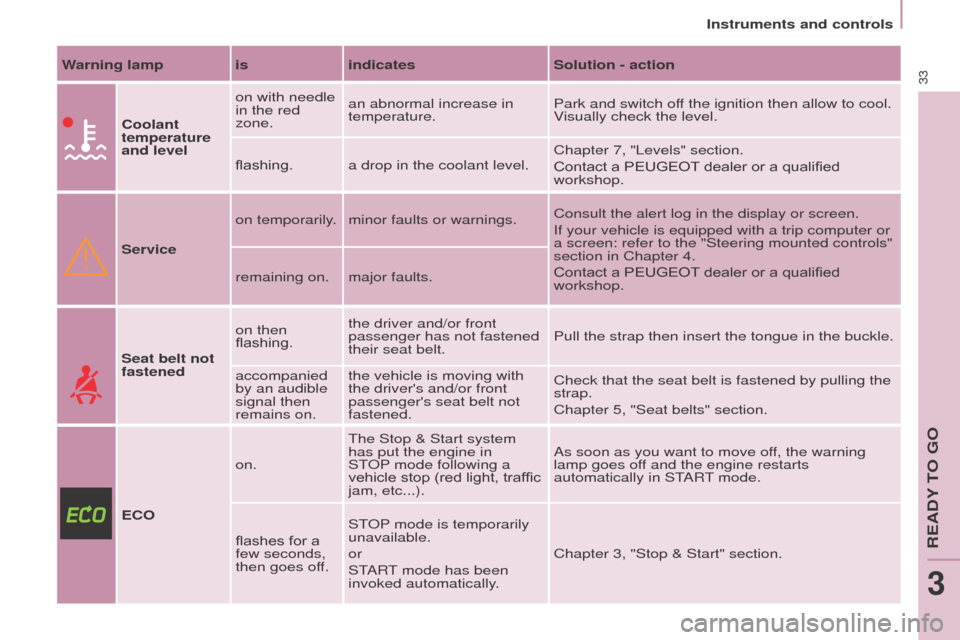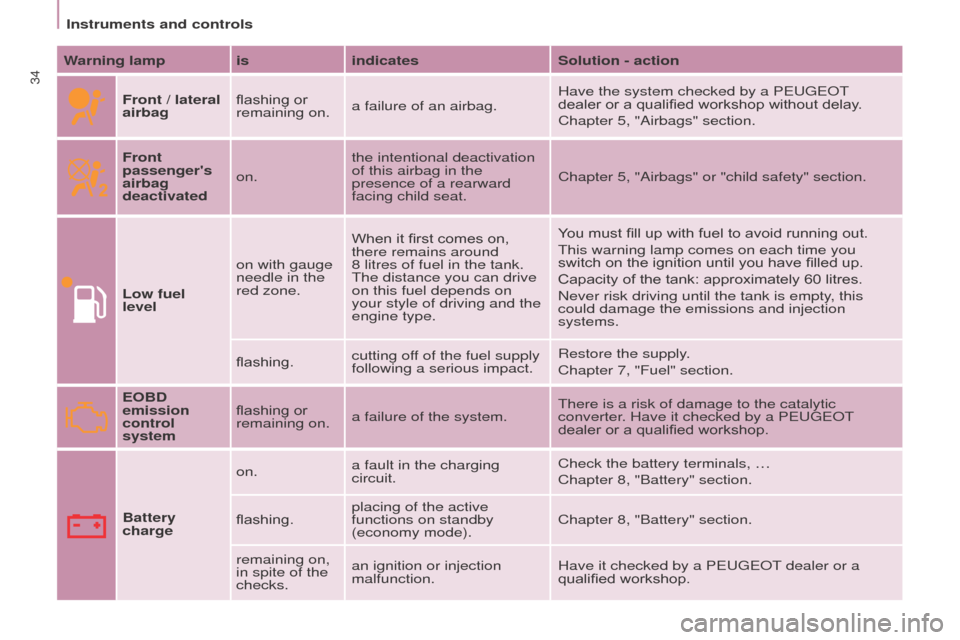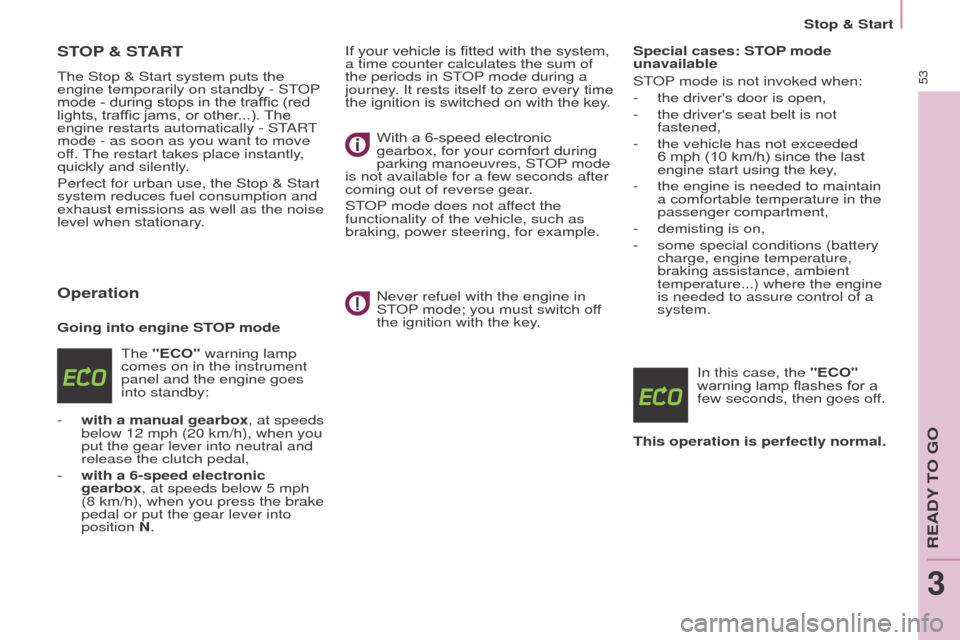seat Peugeot Partner Tepee 2016 Owner's Manual
[x] Cancel search | Manufacturer: PEUGEOT, Model Year: 2016, Model line: Partner Tepee, Model: Peugeot Partner Tepee 2016Pages: 296, PDF Size: 10.76 MB
Page 4 of 296

2
ContentsKey 18
Alarm
20
Doors
21
T
ailgate 23
Rear roof flap
26
Central locking
27
Instrument panel
28
Date and time
29
W
arning lamps
32
Fuel gauge
40
Coolant
40
Under-inflation detection
41
Under-inflation detection with reinitialisation
43
Service indicator
47
Lighting dimmer
48
Steering wheel
adjustment
49
Manual gearbox
49g
ear shift indicator
50
6-speed electronic
gearbox
51
Stop & Start
53
Starting and stopping
55
Hill start assist
56
Driving
recommendations
57Lighting
58
Wipers
61
T
rip computer
63
Cruise control
64
Speed limiter
67
Heating /
Air conditioning
manual
70
digital
72
Demisting and
defrosting
75
Front seats
77
Rear bench seat
79
Rear seats
(5 seat version)
82
Rear seats
(7 seat version)
85
Modularity
92
Front fittings
94
Zenith roof
98
Roof bars
103
Courtesy lamps
104
Load space cover
(5 seat version)
105
Load space cover
(7 seat version)
109
Mirrors
111
e
lectric windows
1
13
3.
18-57
R
e ADY to go5 .
1
14-147
SAF
et Y
exterior 5
Interior 6 left hand drive
6 right hand drive
7
Instruments and controls
8 left hand drive
8 right hand drive
10
T
echnical data - Maintenance
12
oVeRVIeW
1
.
4-14
Hazard warning lamps 1 14
Horn 114
Parking brake
1
14
Parking sensors
1
15
Reversing camera
1
17
Anti-lock braking system
(ABS)
1
18
e
BA
118
ASR and DSC
1
19
g
rip control
120
Active City Brake
122
Seat belts
126
Airbags
129
Carrying children
133
Deactivating the passenger's front
airbag
136
Recommended seats
139
Installation
141
IS
o FIX mountings
143
Recommended IS
o FIX
seat
144
IS
o FIX locations
145
Child lock
147
4.
58-113eAS e o F u S e and
C
o MF o R t
2
.
15-17
e
C
o
-DRIVIN
g
environment 15
Eco-driving 16
The "V
isual Search" (visual
index) section assists
you in finding the controls
and functions and their
associated page numbers
on the schematic outlines of
the vehicle.
Instruments and controls
left hand drive
13 right hand drive
14
Page 8 of 296

6
Location
Rear view mirror 112
Front courtesy lamp 104
Changing courtesy
lamp bulbs
183 Front, lateral,
curtain airbags
129-132
Deactivating the passenger's
front airbag
132, 136
Battery
, charging,
starting
169o
pening the bonnet
154
Rear windows
1
12
Front seats, adjustments,
head restraint
77-78
Seat belts
108, 126-128
Accessories
152
INteRIoR
Rear bench seat 79-81
Rear seats
(5-seat version)
82-84, 92
Seat configuration, benches
92-93
Rear courtesy lamp
104
Changing courtesy lamp bulbs
1
83
Rear fittings
97
-
floor boxes,
-
aircraft style table,
-
side blinds,
Zenith roof
98-99
Scented air freshener
100-101
Load space cover
(5-seat version)
105
Load space cover
(7-seat version)
109-1
10 Child seats
133-142, 145
IS
o FIX mountings, seats 143-145
Parking brake, handbrake
1
14
Rear seats (7-seat version)
85-91, 93
Fittings (7-seat version)
107-108
-
cup holder
,
-
12 V socket,
-
stowing rings,
-
storage flap.
T
owing, llifting
191
T
owable loads
196-199
Spare wheel, jack,
changing a wheel, tools
1
72-177
Page 9 of 296

7
Location
Rear view mirror 112
Front courtesy lamp 104
Changing courtesy lamp
bulbs
183 Front, lateral,
curtain airbags
129-132
Deactivating the passenger's
front airbag
132, 136
Battery
, charging, starting
169o
pening the bonnet
154
Rear windows
1
12
Front seats, adjustments,
head restraint
77-78
Seat belts
108, 126-128 Accessories
152
INteRIoR
Rear bench seat 79-81
Rear seats
(5-seat version)
82-84, 92
Seat configuration, benches
9
2-93
Rear courtesy lamp
104
Changing courtesy lamp bulbs
1
83
Rear fittings
97
-
floor boxes,
-
aircraft style table,
-
side blinds,
Zenith roof
98-99
Scented air freshener
100-101
Load space cover
(5-seat version)
105
Load space cover
(7-seat version)
109-1
10
Child seats
133-142, 145
IS
o FIX mountings, seats
143-145
Parking brake, handbrake
1
14
Rear seats (7-seat version)
85-91, 93
Fittings (7-seat version)
107-108
-
cup holder
,
-
12 V socket,
-
stowing rings,
-
storage flap.
T
owing, llifting
191
T
owable loads
196-199
Spare wheel, jack,
changing a wheel, tools
172-177
1
oVeRVIeW
Page 18 of 296

16
Motoring & the environment
e
co-driving is a range of everyday practices that allow the motorist to o\
ptimise their fuel consumption and C o
2 emissions.
eco-driving
o
ptimise the use of your gearbox
With a manual gearbox, move off gently and change up
without waiting. During acceleration change up early.
With an automatic or electronic gearbox, give preference
to automatic mode and avoid pressing the accelerator
pedal heavily or suddenly.
The gear shift indicator invites you engage the most
suitable gear: as soon as the indication is displayed in the
instrument panel, follow it straight away.
For vehicles fitted with an electronic or automatic gearbox,
this indicator appears only in manual mode.
Drive smoothly
Maintain a safe distance between vehicles, use engine
braking rather than the brake pedal, and press the
accelerator progressively. These practices contribute
towards a reduction in fuel consumption and C o
2
emissions and also helps reduce the background traffic
noise.
If your vehicle has cruise control, make use of the system
at speeds above 25 mph (40 km/h) when the traffic is
flowing well.
Control the use of your electrical equipment
Before moving off, if the passenger compartment is too
warm, ventilate it by opening the windows and air vents
before using the air conditioning.
Above 30 mph (50 km/h), close the windows and leave the
air vents open.
Remember to make use of equipment that can help keep
the temperature in the passenger compartment down
(sunroof and window blinds...).
Switch off the air conditioning, unless it has automatic
regulation, as soon as the desired temperature is attained.
Switch off the demisting and defrosting controls, if not
automatic.
Switch off the heated seat as soon as possible.
Switch off the headlamps and front foglamps when the
level of light does not require their use.
Avoid running the engine before moving off, particularly in
winter; your vehicle will warm up much faster while driving.
As a passenger, if you avoid connecting your multimedia
devices (film, music, video game...), you will contribute
towards limiting the consumption of electrical energy, and
so of fuel.
Disconnect your portable devices before leaving the
vehicle.
Page 19 of 296

17
Motoring & the environment
Limit the causes of excess consumption
Spread loads throughout the vehicle; place the heaviest
items in the bottom of the boot, as close as possible to the
rear seats.
Limit the loads carried in the vehicle and reduce wind
resistance (roof bars, roof rack, bicycle carrier, trailer...).
u
se a roof box in preference.
Remove roof bars and roof racks after use.
At the end of winter, remove snow tyres and refit your
summer tyres.
observe the recommendations on maintenance
Check the tyre pressures regularly, when cold, referring to
the label in the door aperture, driver's side.
Carry out this check in particular:
-
before a long journey
,
-
at each change of season,
-
after a long period out of use.
Don't forget the spare wheel and the tyres on any trailer or
caravan.
Have your vehicle serviced regularly (engine oil, oil
filter
, air filter, passenger compartment filter...) and
observe the schedule of operations recommended in the
manufacturer's service schedule.
With a BlueHDi Diesel engine, if the SCR system is
faulty your vehicle becomes polluting; go to a P
eugeo T
dealer or a qualified workshop without delay to have the
emissions of nitrous oxides brought back to the legal level.
When refuelling, do not continue after the third cut-off of
the nozzle to avoid any overflow.
At the wheel of your new vehicle, it is only after the first
1 800 miles (3 000 kilometres) that you will see the fuel
consumption settle down to a consistent average.
2
eCo-DRIVINg
Page 35 of 296

Instruments and controls
33Warning lamp isindicatesSolution - action
Coolant
temperature
and level on with needle
in the red
zone.
an abnormal increase in
temperature.
Park and switch off the ignition then allow to cool.
Visually check the level.
flashing. a drop in the coolant level. Chapter 7, "Levels" section.
Contact a PEUGEOT
dealer or a qualified
workshop.
Service on temporarily. minor faults or warnings.
Consult the alert log in the display or screen.
If your vehicle is equipped with a trip computer or
a screen: refer to the "Steering mounted controls"
section in Chapter 4.
Contact a PEUGEOT dealer or a qualified
workshop.
remaining on. major faults.
Seat belt not
fastened on then
flashing.
the driver and/or front
passenger has not fastened
their seat belt.
Pull the strap then insert the tongue in the buckle.
accompanied
by an audible
signal then
remains on. the vehicle is moving with
the driver's and/or front
passenger's seat belt not
fastened.
Check that the seat belt is fastened by pulling the
strap.
Chapter 5, "Seat belts" section.
e
C o
on. The Stop & Start
system
has put the engine in
ST
o
P mode following a
vehicle stop (red light, traffic
jam,
etc...).As soon as you want to move off, the warning
lamp goes off and the engine restarts
automatically in START mode.
flashes for a
few seconds,
then goes off. ST
o
P mode is temporarily
unavailable.
or
START mode has been
invoked automatically. Chapter 3, "Stop & Start" section.
ReADY to go
3
Page 36 of 296

Instruments and controls
34
Warning lamp isindicatesSolution - action
Front / lateral
airbag flashing or
remaining on.
a failure of an airbag. Have the system checked by a P
eugeo T
dealer or a qualified workshop without delay.
Chapter 5, "Airbags" section.
Front
passenger's
airbag
deactivated on. the intentional deactivation
of this airbag in the
presence of a rearward
facing child seat. Chapter 5, "Airbags" or "child safety" section.
Low fuel
level on with gauge
needle in the
red zone. When it first comes on,
there remains around
8
litres of fuel in the tank.
The distance you can drive
on this fuel depends on
your style of driving and the
engine type. You must fill up with fuel to avoid running out.
This warning lamp comes on each time you
switch on the ignition until you have filled up.
Capacity of the tank: approximately 60 litres.
Never risk driving until the tank is empty, this
could damage the emissions and injection
systems.
flashing. cutting off of the fuel supply
following a serious impact. Restore the supply.
Chapter 7, "Fuel" section.
eo
BD
emission
control
system flashing or
remaining on.
a failure of the system. There is a risk of damage to the catalytic
converter. Have it checked by a P
eugeo T
dealer or a qualified workshop.
Battery
charge on.
a fault in the charging
circuit. Check the battery terminals, …
Chapter 8, "Battery" section.
flashing. placing of the active
functions on standby
(economy mode). Chapter 8, "Battery" section.
remaining on,
in spite of the
checks. an ignition or injection
malfunction.
Have it checked by a P
eugeo T dealer or a
qualified workshop.
Page 55 of 296

53
StoP & StARt
The Stop & Start system puts the
engine temporarily on standby - STo P
mode - during stops in the traffic (red
lights, traffic jams, or other...). The
engine restarts automatically - START
mode - as soon as you want to move
off. The restart takes place instantly,
quickly and silently.
Perfect for urban use, the Stop & Start
system reduces fuel consumption and
exhaust emissions as well as the noise
level when stationary.
operation
going into engine StoP mode
The " e C o " warning lamp
comes on in the instrument
panel and the engine goes
into standby:
-
with a manual gearbox
, at speeds
below 12 mph (20 km/h), when you
put the gear lever into neutral and
release the clutch pedal,
-
with
a 6-speed electronic
gearbox, at speeds below 5 mph
(8 km/h), when you press the brake
pedal or put the gear lever into
position N. If your vehicle is fitted with the system,
a time counter calculates the sum of
the periods in ST
o
P mode during a
journey. It rests itself to zero every time
the ignition is switched on with the key.
With a 6-speed electronic
gearbox, for your comfort during
parking manoeuvres, ST
o
P mode
is not available for a few seconds after
coming out of reverse gear.
ST
o
P mode does not affect the
functionality of the vehicle, such as
braking, power steering, for example.
Never refuel with the engine in
ST
o
P mode; you must switch off
the ignition with the key. Special cases: S to P mode
unavailable
ST
o
P mode is not invoked when:
-
the driver's door is open,
-
the driver's seat belt is not
fastened,
-
the vehicle has not exceeded
6
mph (10 km/h) since the last
engine start using the key,
-
the engine is needed to maintain
a comfortable temperature in the
passenger compartment,
-
demisting is on,
-
some special conditions (battery
charge, engine temperature,
braking assistance, ambient
temperature...) where the engine
is needed to assure control of a
system.
In this case, the
" e C o "
warning lamp flashes for a
few seconds, then goes off.
t
his operation is perfectly normal.
Stop & Start
ReADY To go
3
Page 56 of 296

54
going into engine StARt mode
The " e C o " warning lamp
goes off and the engine
starts:
-
with a manual gearbox
, when you
fully depress the clutch pedal,
-
with
a 6-speed electronic
gearbox:
●
gear lever in position
A or M,
when you release the brake
pedal,
●
or gear lever in position
N and
the brake pedal released, when
you move the gear lever to
position A or M,
●
or when you engage reverse
gear
.
With a manual gearbox in ST
o
P
mode, if a gear is engaged without
fully depressing the clutch pedal, a
warning lamp comes on or a message
is displayed asking you to depress the
clutch pedal to restart the engine. Special cases: S
tAR t invoked
automatically
For your safety and comfort, START is
invoked automatically when:
-
you open the driver's door
,
-
you unfasten the driver's seat belt,
-
the speed of the vehicle exceeds
15 mph (25 km/h) with a manual
gearbox or 7 mph (1
1 km/h) with
the 6-speed electronic gearbox
system,
-
some special conditions (battery
charge, engine temperature,
braking assistance, ambient
temperature...) where the engine
is needed to assure control of a
system.In this case the
" e C o "
warning lamp flashes for
few
seconds, then goes off.
t
his operation is perfectly normal.
Deactivation
At any time, press the "eCo oFF" switch to deactivate the
system.
This is confirmed by the switch warning
lamp coming on accompanied by a
message in the screen.
If the system has been deactivated
in ST
o
P mode, the engine restarts
immediately.
Reactivation
Press the "eCo oFF" switch again.
The system is active again; this is
confirmed by the switch warning
lamp going of
f and a message in the
instrument panel.
The system is reactivated
automatically at every new start
using the key.
operating fault
In the event of a malfunction
with the system, the " e C o
o
FF" switch warning lamp
flashes, then comes on
continuously.
Have it checked by a P
eugeo T
dealer or a qualified workshop.
In the event of a fault in ST
o
P mode,
the vehicle may stall. All of the warning
lamps in the instrument panel come
on. It is then necessary to switch off
the ignition and start the engine again
using the key.
Stop & Start
Page 79 of 296

77
Seats
FRoNt SeAtS
Forwards/backwards Seat height (driver)
To raise the seat, pull the control
upwards then take your weight off the
seat cushion.
To lower the seat, pull the control
upwards then push on the seat
cushion.
Seat backrest angle
Lift the bar and slide the seat forwards
or backwards.
The following adjustments are
available: With your back pressed against the
seat backrest, move the lever forwards
and set the required angle.
eASe oF uSe and CoMFoRT
4